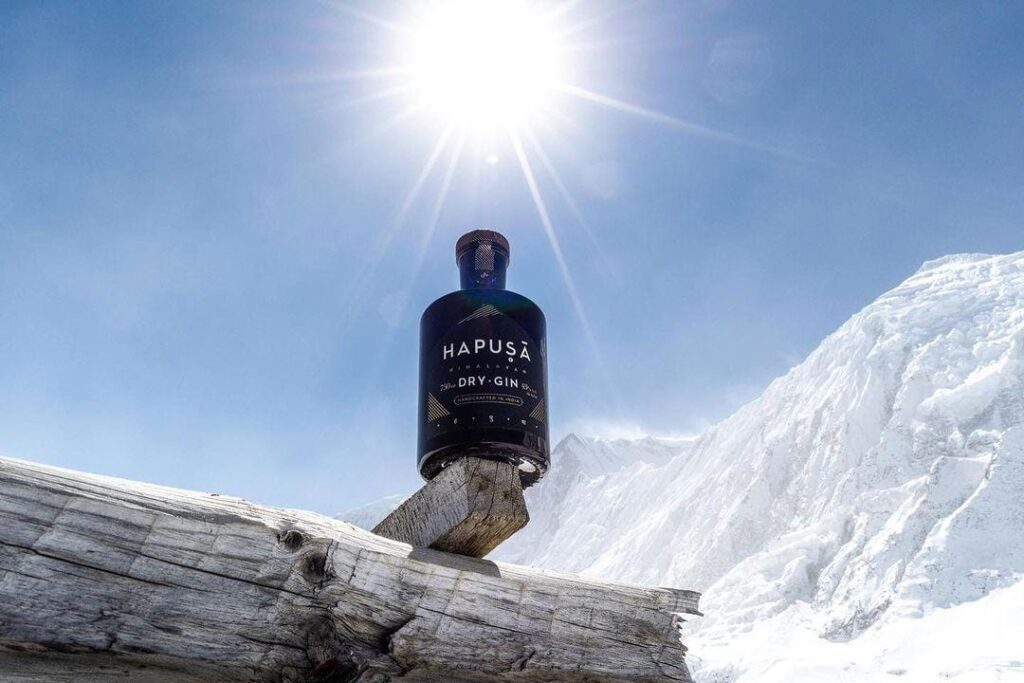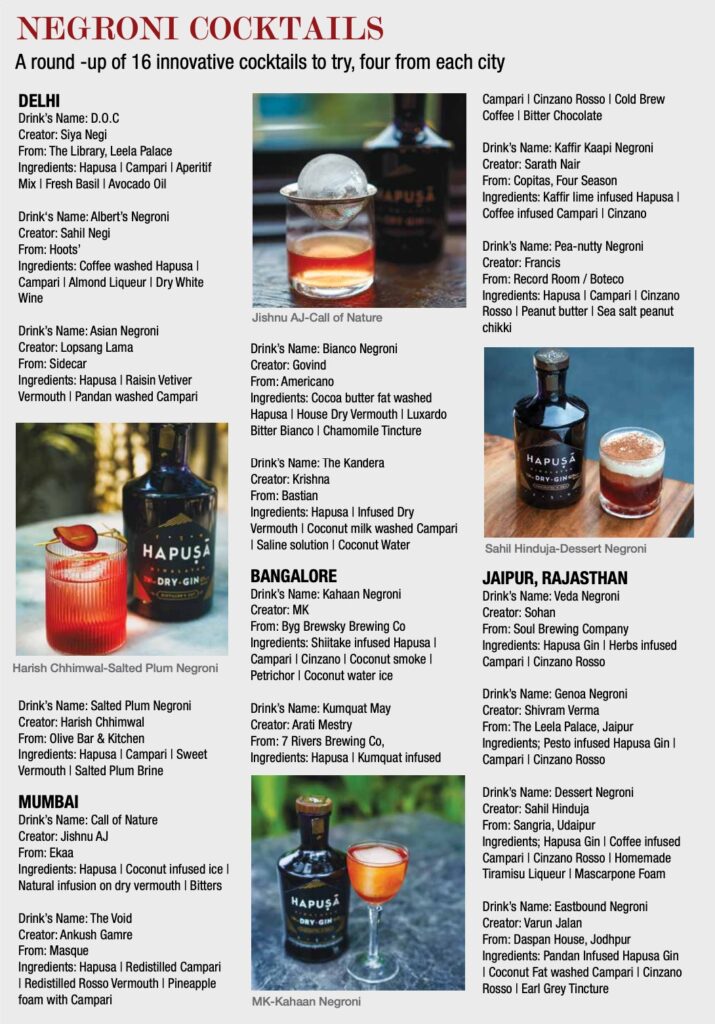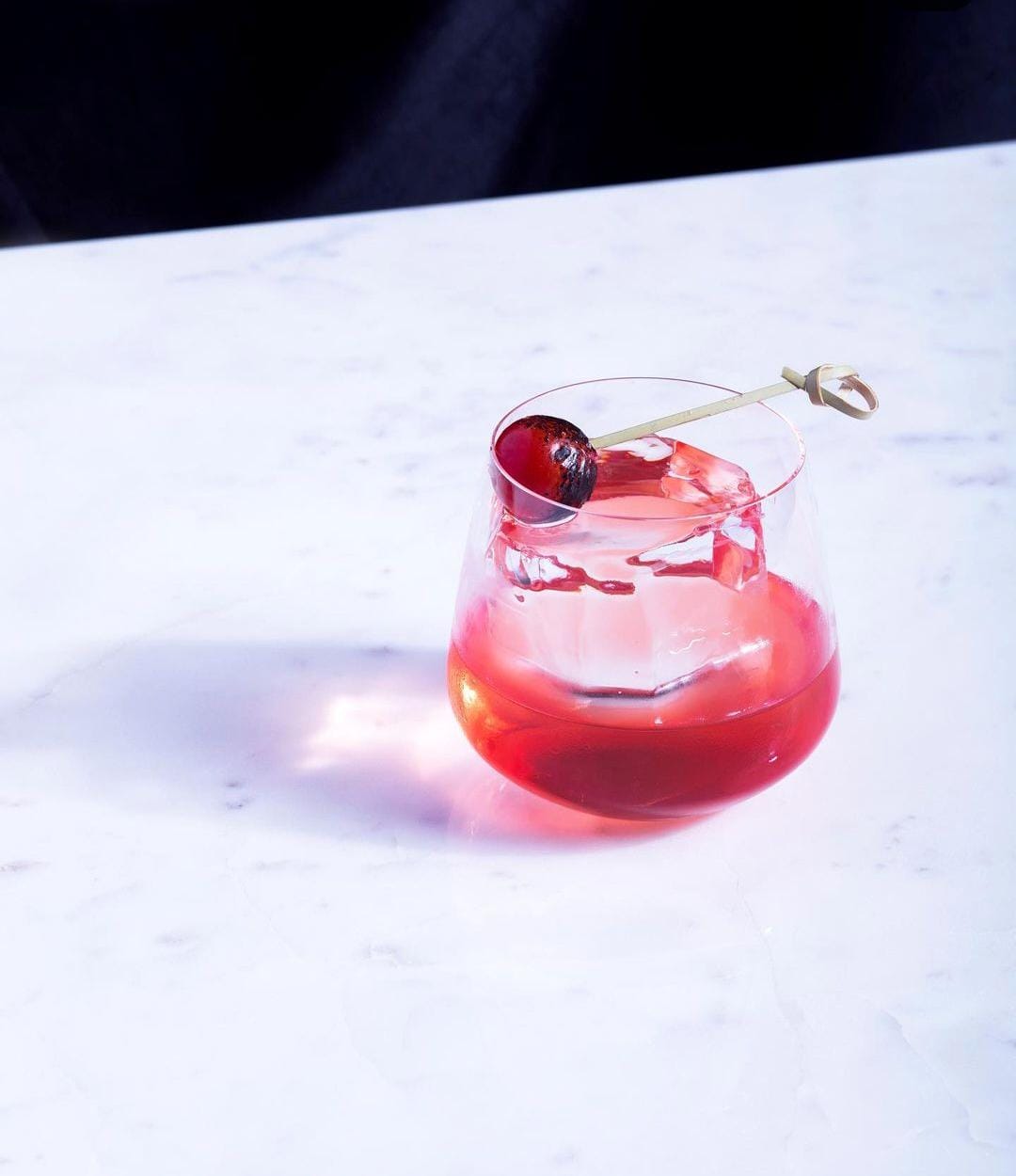It’s the late 1880s to early 1920s. The world was partly gloomy with pandemics, wars, and economic meltdowns. But there was also growing industrialisation, and new urban money. Revelries required bubblies and cocktails, and bars were viewed as therapy clinics. Decades passed, the swings of mood continued, but what remained was the spirited support that gave rise to Classic Cocktails. More than a century later, we still relish them, often putting our own twist to them. To celebrate that birth and reinvention, Hapusa Himalayan Dry Gin, India’s first Himalayan juniper-centric elixir from local-botanicals, set out to explore further. Starting with the Negroni.

The four city study of this unforgettable, sweet-sour, red classic began its expedition from the capital, continuing on to Mumbai, Bengaluru, and Jaipur. The idea was simple: if this 1919-born Italian gem of a drink were to be born today, what would it be? What came up was a plethora of ideas — on styles of glassware, the importance of clear ice, the garnish game, the proportion of amaro, the presence of vermouths, or even no vermouths! Some Negronis went bubbly, some flirted with new ingredients including espuma from whipped up water, milk, cream or eggs… This was an opportunity to break the shackles of the century-old mould and question every pixel that makes up the portrait of the Negroni.

THE NEGRONI STORY
Much like anything etched in history, Negroni’s origin has varied stories, but the story most widely believed places its birth in 1919. A very popular drink, with Campari and Sweet vermouth, was already being relished in Italy, under the moniker ‘Milano Torino’. An apt name because Campari came from a town near Milan, and vermouths came from Turin, and the two were put together in equal parts.
With the imposition of prohibition in the US in 1919, Americans starting travelling abroad, mainly to Florence, the then European banking capital. There they discovered the drink that was all the rage in Italy, the Milano Torino. But finding it too strong for their liking, they started drinking it with a splash of soda water. And the ‘Americano’ was born.
With the imposition of prohibition in the US in 1919, Americans starting travelling abroad, mainly to Florence, the then European banking capital. There they discovered the drink that was all the rage in Italy, the Milano Torino. But finding it too strong for their liking, they started drinking it with a splash of soda water. And the ‘Americano’ was born.
And then one fine day, at the Caffe Casoni in Florence, Count Camillo Negroni ordered an Americano, and asked for the soda water to be replaced with gin, a spirit he had probably encountered during his time as a student in the U.K. This twist to the Americano resulted in the new drink being named after him: Negroni!
WHY THE NEGRONI?
Over the past decade or so, there’s been a global trend of cutting down on sugars. Also, as we mature, our palates naturally tend towards enjoying bitterness and subtle nuances. Think black coffee, dark chocolate, aperitif drinks, IPA beers, and a lot more. This is where Negroni comes into its own, with the subtlety of its balance, and nuanced appreciation of botanicals from the gin, the bitterness of the amaro, and the vermouth. In India, its popularity has been heightened thanks to our home-made gin revolution, so that this classic red Italian aperitif has received renewed attention.
Traditionally, its three ingredients are combined in equal parts, stirred, and served with a fixed garnish, barely providing any scope for variation or experimentation.
Hapusa’s exploration of this classic set outto change all that.
THE EXPLORATION
Each city brought in four champion bartenders to put their own riff on the classic; there was nothing to limit their
creativity. Their creations were first studied by a gathering of the finest bartenders and F&B professionals of the city, and then by consumers at curated bar events.
DELHI
The Library Bar’s Siya Negi challenged the practice of using only sweet vermouth, replacing it with a trilogy of Bianco, Rosso and Fiero. Sahil Negi from Hoots’ discarded vermouths completely, replacing them with an oaky Chardonnay that blended well with the earthy tones of coffee and almond liqueur. Sidecar’s Lopsang Lama’s Negroni toyed with vetiver (khus), raisins, and pandan, ingredients that are globally in vogue on the cocktail scene. The use of raisins also pointed to experimenting with alternative natural sugars, a worldwide movement, so why not in our drinks too? Harish Chhimwal from Olive Bar & Kitchen flirted with a combination of the Negroni and the Gibson, bringing in
salted plum brine, and so marrying India’s historic pickling techniques to a favourite pahadi fruit, the plum. These four renditions were a fantastic window in the play of techniques, bringing in fruity, earthy, aromatic ingredients, and shattering the ‘sameness’ of the Negroni.
MUMBAI
Delhi had set the tone, and Mumbai raised the game to the extent when one had to ask: “When does the Negroni cease beinga Negroni and become another drink?” Ekaa is known for pushing the boundaries and bartender Jishnu displayed that with panache. Why not displace the humble ice in the drink too? Jishnu’s Call of Nature Negroni placed ice as the garnish of the drink. Planted in a strainer on top of the drink, the coconut- infused ice-ball was a visual treat. And the longer you held the drink, the longer the ice continued to drip into it altering the flavour profile with virtually every sip. Sheer genius!
Ankush Gamre at Masque has been touted as the mad scientist behind the bar. Redistilling the Campari and Vermouth rendered the Negroni colourless, and crowning it with a blue-hued Pineapple foam, transformed it into a summery drink, that’s hard to put down. From the first look, one questions whether it’s a Negroni, or a rebirth of the idea in entirety.
While some mixologists were changing the colours, Govind Koranga from the Americano Bar removed colour altogether, coming up with a white Negroni. Cocoa butter fat washed Hapusa Gin met with a bitter vermouth, a
secret blend of amaros, and finished with a Chamomile aromatic, creating a smooth criminal that can bust Mumbai’s heat. Bastian’s Krishna, too, used a dry vermouth with a coconut-washed amaro and a coconut water chuski, embodying the quintessential treat for Mumbai beaches. Mumbai raised the most brows, in awe of the avatars that
the drink can possibly have. These are drinks from the City of Dreams we are still dreaming about.
BENGALURU
Bengaluru took a rather safe approach with their favourite ingredients, coconut and coffee. Byg Brewsky Brewing Co’s MK brought in an umami-driven concoction with Shiitake mushrooms, coconut smoke, and a coconut water, edible ice garnish, something we had documented in Mumbai too. Arati Mestry from 7 Rivers Brewing Co took a twist on the classic orange-slice garnish, replacing it with a kumquat, a seasonal local fruit, and also infusing it into the drink alongside coffee and bitter chocolate, making it a fail-proof proposition. Copitas’s Sarath Nair brought a simple twist with the play of kaffir lime’s tart aromatic panache married with the rusticity of a coffee-infused Campari. The showstopper was the Peanut Negroni from Francis at Boteco restaurant. Maintaining the sanctity of the base of the Negroni, no alterations were made. But in an amazing addition, the drink was washed with decadent peanut butter, bringing all that sweet, caramel, nutty brilliance, that left us somewhat in awe, while the nostalgia satiated the eternal kid inside us. There was a long queue at Francis’s bar that evening.
Jaipur (and Rajasthan)
Jaipur bartenders can be surprising for their experimenting temperament. When was the last time (read first time) you put garlic into your drink, and enjoyed it? Shivram Verma from The Leela Palace is an ace mixologist, known for his love for infusions. His Genoa Negroni is the classic Negroni given an additional Italian accent by
infusing Pesto in it. Yes, pesto. It works, and how! It was incredible how brilliantly the two married together, presenting a culinary treat. Sohan from Soul Brewing Company went the Indian way, paying homage to the spice route that passed through the city, with a bouquet garni of herbs, championed by carom seeds, aka ajwain. Used in numerous dishes across the country, ajwain makes for a tart, spicy, earthy, and elegantly perfumed herb, blending well with the bitterness of the amaro and the botanicals of the gin. Jodhpur’s Daspan House presents the city’s royalty in a modern style; Varun Jalan’s drink did the same. It married coconut oil with Campari, and infused the
starchy texture of Pandan Leaves with the gin, creating a soothing Negroni, accentuated with an Earl Grey tea tincture. Udaipur’s Sangria bar is probably the only freestanding bastion of crafted drink in the city. Sahil Hinduja
brought the bittersweet Negroni and Italy’s beloved dolce, Tiramisu together, creating a delectable treat that made it difficult to leave the bar. It was an aperitif and a dessert in the same glass, how could you let it go? I couldn’t!
These sixteen interpretations are a study that will remain as a notable chapter in the evolution of the drink. Daring attempts to re-do a classic that could have easily irked purists and traditionalists. Instead, they tickled the imagination and palates of all who tasted them, impressing them with the craft of our local bartenders, with new ingredients and techniques that we can proudly boast of, and perhaps export to the rest of the world.


